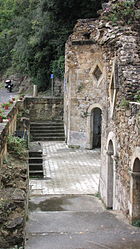Rennes-les-Bains
| Rennes-les-Bains | ||
|---|---|---|

The baths
|
||
|
||
| Coordinates: 42°55′11″N 2°19′11″E / 42.9197°N 2.3197°ECoordinates: 42°55′11″N 2°19′11″E / 42.9197°N 2.3197°E | ||
| Country | France | |
| Region | Occitanie | |
| Department | Aude | |
| Arrondissement | Limoux | |
| Canton | Couiza | |
| Government | ||
| • Mayor (2008–2014) | Alain Girard | |
| Area1 | 18.77 km2 (7.25 sq mi) | |
| Population (2008)2 | 171 | |
| • Density | 9.1/km2 (24/sq mi) | |
| Time zone | CET (UTC+1) | |
| • Summer (DST) | CEST (UTC+2) | |
| INSEE/Postal code | 11310 / 11190 | |
| Elevation | 254–822 m (833–2,697 ft) (avg. 310 m or 1,020 ft) |
|
|
1 French Land Register data, which excludes lakes, ponds, glaciers > 1 km² (0.386 sq mi or 247 acres) and river estuaries. 2Population without double counting: residents of multiple communes (e.g., students and military personnel) only counted once. |
||
1 French Land Register data, which excludes lakes, ponds, glaciers > 1 km² (0.386 sq mi or 247 acres) and river estuaries.
Rennes-les-Bains or Les Banhs de Rènnas is a commune in the Aude department in southern France.
Bathers have enjoyed the natural hot spring waters for thousands of years - they are still used today as a cure for rheumatism and certain skin problems. Today, it is a modern thermal spa with the latest equipment. Due to a microbe found in the piping of the old baths they have been closed and a new hospital built which gets its water from another source. Due to its enormous popularity the 'Bains Forts', an old 'lavoir' where young people have bathed for the last 40 years, have been cemented in and closed indefinitely. This event has led some to rename Rennes-les-Bains, Rennes-sans-Bains.
Rennes-les-Bains is located in the valley of the River Sals, 48 km (30 mi) from Carcassonne, 20 km (12 mi) from Limoux, and 3 km (1.9 mi) from Rennes-le-Château.
The origins of Rennes-les-Bains go back to Antiquity. Archaeological artifacts indicate that the spa was at one time popular with the Roman colony in Colonia Narbo Martius (Narbonne).
Traditionally the serving doctor of the village is also the historian. As of 2007 the current doctor is Dr André Authier who has written one book and co-authored another on "thermalisme".
Rennes-les-Bains is known for another reason, however: it is mentioned numerous times in many books about Rennes-le-Chateau, famous now also because of Dan Brown's novel The Da Vinci Code. Subsequently, the author Kate Mosse set the larger part of her 2007 novel Sepulchre in the immediate vicinity.
Abbé Henri Boudet was the parish priest of Rennes-les-Bains at the same time that Bérenger Saunière was the incumbent of Rennes-le-Château. Boudet's strange book, La vraie langue celtique et le cromleck de Rennes-les-Bains (1886) argued that all languages were derived from the English tongue whereby the Abbé tried to establish his theory through the use of puns.
...
Wikipedia



